英语句型结构与句子成分划分复习课程
英语句子成分及结构解析优质课件

英语句子成分及结构解析优质课件一、教学内容本节课我们将深入学习英语句子的成分及结构解析。
教材选用《新概念英语》第二册第五章“时态的运用”及第六章“句子结构分析”。
具体内容包括:句子基本成分(主语、谓语、宾语、定语、状语、表语)、句子结构(简单句、并列句、复合句)以及不同句型的转换和运用。
二、教学目标1. 理解并掌握英语句子的基本成分及其作用。
2. 学会分析不同类型的句子结构,并能灵活运用。
3. 培养学生的句子转换和运用能力,提高英语表达能力。
三、教学难点与重点教学难点:句子结构分析及句子转换。
教学重点:句子基本成分的作用及运用。
四、教具与学具准备教具:PPT、黑板、粉笔。
学具:笔记本、教材。
五、教学过程1. 实践情景引入(5分钟)利用PPT展示一个日常交流场景,引导学生关注句子成分及结构。
2. 理论讲解(10分钟)讲解句子基本成分、句子结构,并通过例句进行演示。
3. 例题讲解(15分钟)分析教材中的例题,引导学生学习句子成分及结构分析方法。
4. 随堂练习(10分钟)分组进行随堂练习,让学生运用所学知识分析句子成分及结构。
5. 互动环节(10分钟)学生相互讨论、分享学习心得,教师解答学生疑问。
六、板书设计1. 句子基本成分:主语、谓语、宾语、定语、状语、表语。
2. 句子结构:简单句、并列句、复合句。
3. 句子转换方法:主动语态与被动语态、否定句与肯定句、疑问句与陈述句。
七、作业设计1. 作业题目:(2)将下列简单句改写为复合句:I like apples. I am healthy.(3)运用所学的句子转换方法,将下列句子进行转换:He often reads books.答案:(1)主语:The book;谓语:is;宾语:on the desk;定语:mine。
(2)I like apples because they make me healthy.(3)He reads books frequently.八、课后反思及拓展延伸1. 课后反思:本节课学生对句子成分及结构掌握情况良好,但仍需加强练习,提高句子转换能力。
英语句子成分详细讲解课件

英语句子成分详细讲解课件一、教学内容本课件基于英语语法教学教材第四章“句子结构分析”部分,详细内容涵盖英语句子的基本成分,包括主语、谓语、宾语、表语、定语、状语以及同位语。
着重讲解各成分的功能、位置以及在实际语境中的应用。
二、教学目标1. 让学生掌握英语句子的基本成分,理解其语法功能。
2. 培养学生分析句子结构的能力,提高句子构建技巧。
3. 帮助学生运用所学知识进行日常交流和写作。
三、教学难点与重点1. 教学难点:定语和状语的区分与使用。
2. 教学重点:句子基本成分的功能、位置及实际应用。
四、教具与学具准备1. 教具:PPT课件、黑板、粉笔。
2. 学具:笔记本、教材、练习册。
五、教学过程1. 实践情景引入(5分钟)通过一个简短的对话,让学生感受句子成分在实际交流中的作用。
2. 知识讲解(15分钟)介绍句子成分的定义、功能及位置。
结合教材例句,详细讲解主语、谓语、宾语、表语、定语、状语及同位语。
3. 例题讲解(10分钟)出示几个典型例题,引导学生分析句子成分。
解答学生疑问,巩固所学知识。
4. 随堂练习(15分钟)让学生独立完成教材上的练习题,检查学习效果。
老师巡回指导,解答学生问题。
5. 小组讨论(5分钟)学生分成小组,讨论并分析教材中的句子成分。
各小组汇报讨论成果,共同学习。
引导学生思考句子成分在写作和口语中的应用。
六、板书设计1. 句子成分的定义、功能及位置。
2. 典型例题及解答步骤。
七、作业设计The beautiful girl in red is my sister.He reads books after dinner every day.2. 答案:句子1:主语(The beautiful girl in red)、谓语(is)、宾语(my sister)。
句子2:主语(He)、谓语(reads)、宾语(books)、状语(after dinner every day)。
八、课后反思及拓展延伸1. 学生反馈:了解学生在课堂上的掌握情况,及时解答疑问。
句子成分和句子结构(31张PPT)初中英语专项复习课件

AB C
D
③ She find it difficult to do the work.
ABC
D
④ They call me Lily sometimes.
AB C
D
⑤ I saw Mr. Wang get on the bus.
主 表 宾 定 状 宾补
1) 主语(subject) 句子的主体,全句述说的对象。一般由担任,常置于句首。
名词,主格代词 ,动词不定式,动名词或从句
I like football. The boy needs a pen. 2) 谓语(predicate) 说明主语的动作或状态。由 动词 担任。常置于主语后。 The train leaves at 6 o’clock. I want a ticket.
I am very sorry. We often help him. When I grow up , I am going to be a teacher . (从句作时间状语)
八大句子成分
主语 谓语 宾语 宾语补足语 表语 定语 状语 同位语
十大词类
冠词 名词 代词 数词 形容词 副词 介词短语 动名词 动词不定式 分词
5) 宾补(objective complement) 补充说明宾语的情况 。 由n. /adj. /介宾 /分词 /不定式等担任。 They made him‹king.› I consider the book‹too expensive.›
6) 定语(attributive) 对名词或代词起修饰、限定作用的词、短语或句子, 汉语中常用‘……的’表示,通常位于被修饰的成分前。
这间屋子里的男孩子们是10班的。 The students in the room are in Class Nine.
初中英语句子结构讲解教案

初中英语句子结构讲解教案教学目标:1. 让学生掌握英语的基本句子结构,包括主语、谓语、宾语、定语、状语等成分。
2. 培养学生正确运用句子结构进行表达的能力。
3. 提高学生对英语句子的理解和运用能力。
教学内容:1. 英语句子的基本结构2. 句子成分的识别和运用3. 不同句子结构的表达方式教学过程:一、导入(5分钟)1. 引导学生回顾已学的英语单词和短语。
2. 提问:你们知道英语句子是由哪些部分组成的吗?二、讲解句子结构(15分钟)1. 介绍英语句子的基本结构,包括主语、谓语、宾语、定语、状语等成分。
2. 通过示例句子,讲解各个成分的作用和位置。
3. 强调句子结构的重要性,引导学生注意句子成分的搭配。
三、句子成分练习(15分钟)1. 给学生发放练习题,要求识别和标出句子中的各个成分。
2. 引导学生运用所学知识,独立完成练习题。
3. 讲解练习题中的重点和难点,让学生充分理解句子结构。
四、不同句子结构的表达方式(15分钟)1. 介绍不同句子结构的特点和用法。
2. 通过示例句子,讲解各种句子结构的表达方式。
3. 引导学生进行句子结构的练习,提高运用能力。
五、总结和作业布置(5分钟)1. 对本节课的内容进行总结,强调句子结构的重要性。
2. 布置作业:要求学生运用所学知识,写出一个完整的句子,并正确标出各个成分。
教学评价:1. 课后收集学生的作业,检查对句子结构的掌握程度。
2. 在下一节课开始时,让学生进行句子结构的知识测试,以评估学习效果。
3. 观察学生在日常英语学习中的表现,了解对句子结构的应用能力。
教学反思:本节课通过讲解和练习,让学生掌握了英语句子的基本结构,提高了对句子成分的识别和运用能力。
在教学过程中,要注意引导学生注意句子结构的搭配,避免出现成分残缺或错误的情况。
同时,要加强练习,让学生在实际应用中灵活运用所学知识。
高考英语复习学案:句子成分和句子结构专题(2020版)
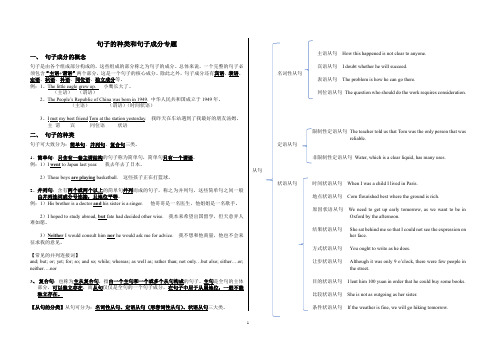
句子的种类和句子成分专题一、句子成分的概念句子是由各个组成部分构成的,这些组成的部分称之为句子的成分。
总体来说,一个完整的句子必须包含“主语+谓语”两个部分,这是一个句子的核心成分。
除此之外,句子成分还有宾语、表语、定语、状语、补语、同位语、独立成分等。
例:1、The little eagle grew up. 小鹰长大了。
(主语)(谓语)2、The People’s Republic of China was born in 1949. 中华人民共和国成立于1949年。
(主语)(谓语)(时间状语)3、I met my best friend Tom at the station yesterday. 我昨天在车站遇到了我最好的朋友汤姆。
主谓宾同位语状语二、句子的种类句子可大致分为:简单句、并列句、复合句三类。
1、简单句:只含有一套主谓结构的句子称为简单句,简单句只有一个谓语。
例:1)I went to Japan last year. 我去年去了日本。
2)These boys are playing basketball. 这些孩子正在打篮球。
2、并列句:含有两个或两个以上的简单句并列而成的句子,称之为并列句,这些简单句之间一般由并列连词或分号连接,且地位平等。
例:1)His brother is a doctor and his sister is a singer. 他哥哥是一名医生,他姐姐是一名歌手。
2)I hoped to study abroad, but fate had decided other wise. 我本来希望出国留学,但天意弄人难如愿。
3)Neither I would consult him nor he would ask me for advice. 我不想和他商量,他也不会来征求我的意见。
【常见的并列连接词】and; but; or; yet; for; so; and so; while; whereas; as well as; rather than; not only…but also; either….or; neither….nor3、复合句:也称为主从复合句,指由一个主句和一个或多个从句构成的句子。
高中英语句子成分基本句型课件公开课

04
课件教学方法
教学方法介绍
讲解法:通过讲解语法规则和例句,帮助学生理解句子成分和基本句型
练习法:通过练习题和例句,让学生在实际应用中掌握句子成分和基本句型
讨论法:通过小组讨论和分享,让学生互相学习,共同提高 游戏法:通过游戏和竞赛,激发学生的学习兴趣,提高学习效果
教学方法特点
互动式教学: 通过提问、讨 论等方式,提 高学生的参与 度和学习兴趣
03
课件内容详解
句子成分介绍
宾语:表示动作的承受者或 接受者,通常位于谓语之后
谓语:表示主语的行为或状 态,通常位于主语之后
主语:句子的主要行动者或 接受者,通常位于句首
定语:修饰名词或代词,通 常位于名词或代词之前
状语:修饰动词、形容词、副 词或整个句子,通常位于句首
或句尾
补语:补充说明主语或宾语 的情况,通常位于句尾
案例教学:通 过具体的案例, 帮助学生理解 和掌握知识点
情景教学:创 设真实的语言 环境,让学生 在实际情境中 运用所学知识
任务教学:通 过布置任务, 让学生在完成 任务的过程中 学习和掌握知
识
教学方法应用实例
情景教学法:通过创设情境,让学生在情境中理解和掌握英语句子成分和基本句型。
游戏教学法:通过设计有趣的游戏,让学生在游戏中学习和掌握英语句子成分和基本句型。
内容:包括名词、动词、形容词、副词等句子成分,以及简单句、复合句、并列句等基本句 型
教学方法:通过实例讲解、练习和互动问答等方式进行教学
课件结构
开场白:介绍课程内容、目的和意义
基本句型介绍:介绍高中英语基本句型,包 括主谓宾、主系表等
句型结构分析:对基本句型进行详细分析, 包括句子成分、结构特点等
五种基本句型及句子成分的分析教案

五种基本句型及句子成分的分析教案一、教学目标1. 让学生掌握五种基本句型:S+V+O、S+V、S+V+IO、S+V+P、S+V+O+OC。
2. 让学生了解句子成分的分类及功能,能够分析句子成分。
3. 提高学生对英语句子的理解和表达能力。
二、教学内容1. 五种基本句型及例子:a. S+V+O:主语+动词+宾语例如:I (S) like (V) apples (O).b. S+V:主语+动词例如:She (S) reads (V).c. S+V+IO:主语+动词+宾语+宾语补足语例如:We (S) call (V) him (IO) John.d. S+V+P:主语+动词+介词短语例如:They (S) are (V) in (P) the classroom.e. S+V+O+OC:主语+动词+宾语+宾语补足语例如:I (S) think (V) she (O) is (OC) a teacher.2. 句子成分及功能:a. 主语(Subject):句子谈论的人或事物。
例如:The cat (S) is sleeping.b. 谓语(Predicate):句子表达的动作或状态。
例如:Eats (V) the mouse (S).c. 宾语(Object):动作的承受者。
例如:I (S) like (V) apples (O).d. 宾语补足语(Object Complement):补充说明宾语的状态或性质。
例如:She (S) calls (V) him (O) John.e. 状语(Adverbial):修饰动词、形容词、副词或整个句子。
例如:Quietly ( Adv ) he (S) opens (V) the door.f. 定语(Attributive):修饰名词,说明名词的性质、数量、状态等。
例如:The red (Attr) car (N) is fast.g. 补语(Complement):补充说明主语的状态或性质。
专题复习1_基本句子结构
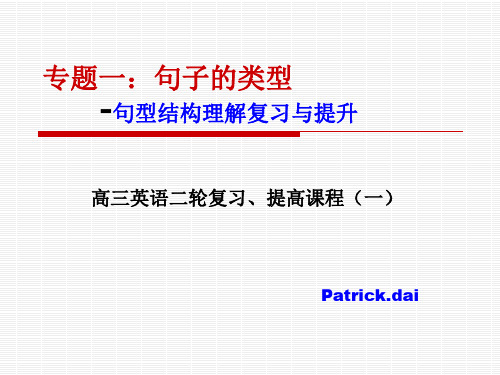
二、谓语 英语中动词一共分为四类:实义动词、连系动词、情态动词和 助动词,实义动词又分为及物动词和不及物动词。实义动词可以单 独作谓语;连系动词需要和表语构成谓语;情态动词和助动词需要 和实义动词或连系动词一起构成谓语。 He worked hard all day today. 他今天苦干了一天。(实义动词作谓语) The park looks beautiful. 这个公园看起来很漂亮。(连系动词+表语作谓语) You must finish the project by Friday. 周五前你必须完成任务。(情态动词+实义动词作谓语) We have finished reading the book. 我们已经看完了这本书。(助动词+实义动词作谓语)
六、状语 状语用于修饰动词、形容词、副词或整个句子。可以 用作状语的有:副词… Frightened, she asked me to go with her. 由于害怕,她要我跟她一起去。(形容词作状语) I opened the window to let some fresh air in. 我打开窗户让新鲜空气进来。(不定式作状语) By talking with them, my oral English improved a lot. 通过跟他们交谈,我的口语提高了很多。(介词短语作 状语)
点津:简单句的骨架就是一个主谓结构!
一、简单句
定义:只有一个主语(或并列主语)和一个谓语 (或并列谓语)构成的句子叫做简单句。例如:
1,Alice studied hard. 2,Li Ming and Zhang Hua work in the same factory. 3,Both Tony and Jim go to school at seven in the morning, have lunch there and come back at five in the afternoon.
句子成分(35张PPT)初中英语专项复习课件

介词短语作 The boy under the tree is John. 树下的那个男孩
定语
是约翰。
成分
用法
例句
副词作定语
She met me on her way home. 她在回家的路上 遇到了我。
定语
动词不定 式作定语
He has a lot of work to do today. 今天他有大量 的工作要做。
句子成分
初中英语专项复习课件
构成篇章的基本单位是句子,组成句子的各个部 分叫作句子成分。句子成分都是由单词、短语或从 句充当的。句子成分主要有主语、谓语、宾语、表 语、定语、状语、宾语补足语和同位语等。句子成 分的考查体现出了多样性,单项选择、翻译和书面 表达等题型都会有所涉及。在学习过程中,正确分 析单词、短语或从句所充当的句子成分是很重要的。
成分 用法
例句
动词不定 To hesitate means failure. 犹豫不决意味着失败。
式作主语
It's my honor to make a speech here. 在这里发言是我的荣幸。
主语
动名词 Seeing is believing. 眼见为实。
作主语
Eating more vegetables is good for your health. 多吃蔬菜对你的健康有好处。
成分 用法
例句
代词作定语
Open your mouth and put out your tongue. 张开嘴,伸出舌头。
定语
数词作定语
She spent seven days on the beach. 她在海滩上度 过了七天。
名词作定语 This is a stone table. 这是一张石桌。
高考英语_句子成分和句型课件

6.His job is to teach English. (不定式) 7.His hobby is playing football. (动名词) 8.The meeting is of great importance. (介词短语) 9.Time is up. The class is over. (副词) 10.The truth is that he has never been abroad. (表语从句)
应试策略
考点一、谓语动词
1.The exam, which was originally to be was changed held in our classroom, ____________ (change) to the library at the last minute. 2.They didn’t take many chances in their lives. They usually _________ followed (follow) orders. 3.I had to leave work to take him to the had broken hospital because he __________ (break) his finger.
(it作形式主语,真正的主语为后面的不定式)
(三)谓语
• 谓语 (Predicate) 说明主语所做的动作或 具有的特征和状态。动词在句中作谓语, 一般放在主语之后。谓语的构成如下: • 1、简单谓语:由一个动词或动词短语构 成。如: He practices running every morning. The plane took off at ten o’clock.
应试策略
括号内给出动词的原形,做题时首先找出句子
英语初高衔接课---句子基本结构、句子成分(教师版)

英语初高衔接课句子基本结构、句子成分(教师版)PresentationⅠ. 简单句(Simple sentence):回忆简单句的五种基本句型Ⅱ. 并列句(Compound sentence):什么叫并列句?学过的并列连词有哪些?1.定义:并列句是由并列连词把两个或两个以上的简单句连接起来的句子,其结构为“简单句+并列连词+简单句”。
常见的并列连词有and, but, or ,so, not only…but also…, neither…nor…, either…or…等e.g. 再试一次吧,或许你就能赢得去意大利的免费车票。
(用横线划出并列的句子及并列连词)我们邻近的电影院又小又旧,但是他们的却又大又现代。
(中译英)The cinema in our neighborhood is old and small, but theirs is big and modern.小心,否则你会打碎那个花瓶的!(中译英)Be careful, or you will break that vase!Jack在每门功课上都努力学习,因此他上学期获得了奖学金(scholarship)。
(中译英)Jack worked very hard at every subject, so he gained a scholarship last term.他不但认识她而且他们还是好朋友。
(中译英)Tom既不留长发,也不穿牛仔裤。
(中译英)2.知识拓展:用and、as well as、neither(nor)等并列连词连接并列句时,某些重复的成分常被省略。
e.g.I don’t know, nor does she (know).●不少并列连词具有对称性,这样的连词常见的有:and, not only…but also…, 利用连词的对称性,可以由连词一边的结构推断出另一边的结构。
e.g. Unfortunately, the rear(后面,后部)of my car was heavy because the engine was there and alsobecause there was a new weight-lifting set laid in the back seat, my car turned completely around on the slippery road.A woman in a night dress and a borrowed(借来的)man’s coat screamed when she saw me andcame (come) running madly. (14年高考一模语法填空题)Ⅲ. 复合句(Complex sentence):什么叫复合句?你所学的复合句有哪些?宾语从句需要遵循什么样的时态及语序规则?1.定义:复合句是由一个主句和一个或一个以上的从句构成。
初高衔接英语句子成分教案
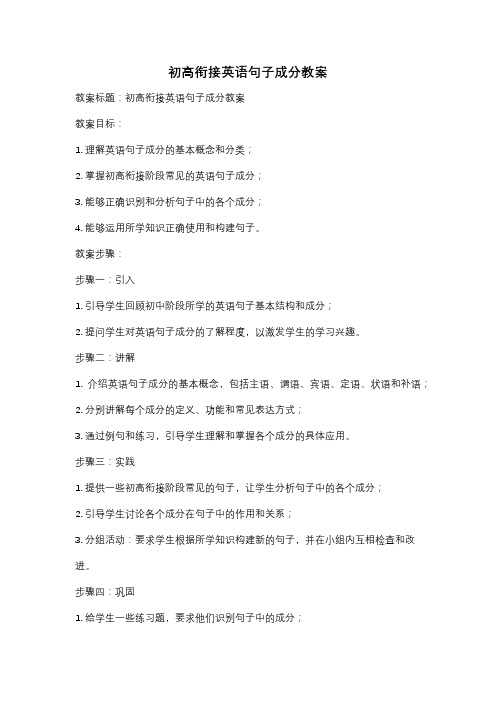
初高衔接英语句子成分教案教案标题:初高衔接英语句子成分教案教案目标:1. 理解英语句子成分的基本概念和分类;2. 掌握初高衔接阶段常见的英语句子成分;3. 能够正确识别和分析句子中的各个成分;4. 能够运用所学知识正确使用和构建句子。
教案步骤:步骤一:引入1. 引导学生回顾初中阶段所学的英语句子基本结构和成分;2. 提问学生对英语句子成分的了解程度,以激发学生的学习兴趣。
步骤二:讲解1. 介绍英语句子成分的基本概念,包括主语、谓语、宾语、定语、状语和补语;2. 分别讲解每个成分的定义、功能和常见表达方式;3. 通过例句和练习,引导学生理解和掌握各个成分的具体应用。
步骤三:实践1. 提供一些初高衔接阶段常见的句子,让学生分析句子中的各个成分;2. 引导学生讨论各个成分在句子中的作用和关系;3. 分组活动:要求学生根据所学知识构建新的句子,并在小组内互相检查和改进。
步骤四:巩固1. 给学生一些练习题,要求他们识别句子中的成分;2. 分享答案,让学生互相检查和纠正;3. 引导学生总结所学内容,强化对英语句子成分的理解和应用。
步骤五:拓展1. 提供一些拓展阅读材料,让学生运用所学知识分析和理解文章中的句子成分;2. 引导学生讨论句子成分在不同文章中的变化和差异;3. 鼓励学生尝试运用所学知识写作简单的段落或文章。
步骤六:总结1. 整理学生的学习成果,让他们总结所学知识和经验;2. 引导学生思考英语句子成分在日常生活和学习中的应用价值;3. 提醒学生继续巩固和拓展所学知识。
教案评估:1. 通过学生的参与度和回答问题的准确性,评估他们对英语句子成分的理解程度;2. 通过练习题和小组活动的表现,评估学生是否能够正确识别和分析句子中的各个成分;3. 通过拓展阅读和写作的表现,评估学生是否能够运用所学知识进行更复杂的语言表达。
教案扩展:1. 针对不同学生的学习需求,可以提供更多的练习题和拓展阅读材料;2. 可以引导学生进行口头表达和写作练习,要求他们运用所学知识构建更复杂的句子和段落;3. 可以组织学生进行小组或班级比赛,通过团队合作来巩固和拓展所学知识。
高考英语复习语法知识讲解讲义(5种基本句型+4种句子成分)

高考英语基本句型英语中常见的句型有以下五种:1、主语 + 谓语2、主语 + 谓语 + 宾语3、主语 + 谓语 + 间接宾语 + 直接宾语4、主语 + 谓语 + 宾语 + 宾语补足语5、主语 + 谓语(系动词)+ 表语一、主谓结构I write、(我写字)You smile、(你微笑)He leaves、(他离开了)She dances、(她跳舞)The river floods、(河水泛滥)The accident happened、(那场事故发生了)某人(或事物)做某事,其中某人(或事物)是动作或行为的发起者,我们称其为主语,后面的动作或行为我们称之为谓语。
二、主谓宾结构I write a letter.You leave your home.He goes to school.She beats me.The flood destroys many houses.The accident causes 2 deaths.上述句子的共同点在于除了表示某人(或事物)做某事之外,还牵涉了另一个人(或事物),这个人(或事物)作为动作或行为的承受者,我们称其为宾语。
三、主谓+双宾结构I write you a letter.His father left him a lot of money.He bought me a new phone.She told me the truth.The government gave him a new mission.在主谓宾结构之外,上述句子又增加了一个人(或事物)作为动作的承受者,也就是又一个宾语。
也可以改写为:I wrote a letter to you.His father left a lot of money to him.He bought a new phone for me.She told the truth to me.The government gave a new mission to him.可以看到,这样调整之后句子的前半部分仍然是完整的主谓宾结构。
教案1英语句子成分结构详解
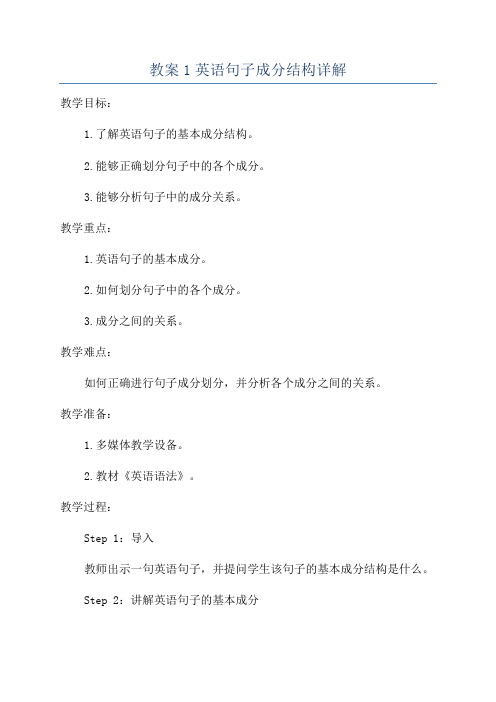
教案1英语句子成分结构详解教学目标:1.了解英语句子的基本成分结构。
2.能够正确划分句子中的各个成分。
3.能够分析句子中的成分关系。
教学重点:1.英语句子的基本成分。
2.如何划分句子中的各个成分。
3.成分之间的关系。
教学难点:如何正确进行句子成分划分,并分析各个成分之间的关系。
教学准备:1.多媒体教学设备。
2.教材《英语语法》。
教学过程:Step 1:导入教师出示一句英语句子,并提问学生该句子的基本成分结构是什么。
Step 2:讲解英语句子的基本成分教师向学生介绍英语句子的基本成分,包括主语、谓语、宾语、定语、状语和补语等。
并结合多个例句,向学生解释每个成分的作用和用法。
Step 3:划分句子中的成分教师给学生出示一些句子,并要求学生独立划分句子中的各个成分。
教师可以提供一些提示,如找出句子的主语、谓语等。
Step 4:分析成分之间的关系教师引导学生分析划分好的句子成分之间的关系,并解释不同成分之间的逻辑关系。
Step 5:巩固练习教师给学生发放练习册,并要求学生独立完成练习册中的句子划分题目。
随后,教师选几个学生上台将自己划分的句子成分进行讲解和分享。
Step 6:总结和归纳教师对学生所学的英语句子成分进行总结和归纳,并提醒学生在阅读和写作中要注意句子成分的正确使用和搭配。
Step 7:布置作业教师布置相关的作业,要求学生练习划分句子成分,并写出自己对句子成分的理解和运用。
Step 8:课堂小结教师对本节课的内容进行小结,并提问学生对教学内容的掌握情况。
教学延伸:1.教师可以鼓励学生在课后继续进行句子成分的练习,并提供相关的练习资料。
2.教师可以引导学生进行更加复杂的句子成分分析,如复合句和独立主格结构等。
3.教师可以进行一些创设情景的活动,让学生在实际语境中运用句子成分结构。
4.教师可以组织学生进行小组合作学习,让学生互相帮助、讨论和分享自己对句子成分的理解和应用。
英语句子成分和句子结构分析复习课程

英语句子成分和句子结构分析英语句子成分和句子结构分析语法讲解1认识语法一、英语语法分为两大部分词法(微观遣词);句法(宏观造句)01词法(微观遣词)1. 实词:有实际意义的词。
名词n.:表事物名称动词vi./vt.:行为,动态。
vi.不及物动词,本身可以表达完整意义,后面不需要带宾语vt.及物动词,本身无法表达完整意义,后面必须带宾语形容词adj.:修饰n.副词adv.:修饰v./adj.或者句子中其他adv或者整个句子代词Pron.:代替n.数词num.:表数量(基数词),表顺序(序数词)2. 虚词:没有实际意义的词。
介词prep.:说明词与词之间的关系连词conj.:说明句子与句子之间的关系冠词art.:在n.前,限定n.感叹词int.:表达感叹02句法(宏观造句)1.句子的成分2.句子结构3.句子的变化4.句子的功能5.句子的类型:简单句,并列句,复合句6.复合句:名词性从句,定语从句,状语从句二、语法四大原则1. 词性决定词用2. 同类同用同种类型的词,用法相同,越细分,越一致3. 动词即句魂句子里最重要的是谓语,谓语部分最重要的就是动词4. 举一反三由表及里,发掘句子结构,归属;认识句子本质,由点及面,放大到句群。
语法精讲2句子的成分主体:主语,谓语,宾语,表语次体:定语,状语,补语,同位语主语:一个句子的主体,是全句述说的对象。
常由名词,代词或相当于名词或代词的词担任,一般放在句首。
The sun(名词n.) rises in the east.W e(代词pron.) are friendsT wenty years(数词num.) is a short time in history.S eeing(动名词) is believingT o be a teacher(不定式)is my dreamW hat he needs (句子)is a book 主语从句I t (形式主语)is time to go home(真正的主语)形式主语是为保持句子平衡谓语:表示主语的行为或状态,常用动词或动词词组担任,放在主语的后面W e study(实意动词) English!I can(情态动词)do it!I don’t(助动词)know!H e is(系动词)asleep.宾语:表示谓语行为的对象,常由名词,代词或相当于名词的词担任,一般放在及物动词或者介词之后。
英语句子成分结构专讲课件

目 录
01 英语句子成分
02 英语句子结构
英语句子成分
英语句子成分分为: 1.主语 subject 2.谓语 predicate 3.宾语 object 4.表语 predicative 5.定语 attribute 6.状语 adverbial 7.补足语(宾补)object complement 8.同位语 appositon
分析句子 "To finish the project will take me two days": To finish the project: 这是一个不定式短语,作为主语。在句中起 名词的作用,表示动作的目的或意义。 will take: 这是谓语动词,表示未来将要发生的动作。 me: 这是间接宾语,表示动作的承受者。 two days: 这是直接宾语,表示动作的时间量词。 整个句子可以重组为:It will take me two days to finish the project. 这样更容易理解句子的结构。
名词 不定式短语 形容词 过去分词表被动 现在分词
表语 Predicative
概念:表语;又叫主语补足语。用来说明主语的身份, 品性,特征和状态。
I am a teacher.我是老师 (老师作表语,用来说明主语“我”的身份) Mike is honest. She is beautiful. China is strong. The cake smells delicious. (蛋糕闻起来很好吃。)这里的 "delicious" 是 Predicate Adjective,描 述了主语 The cake 的性质。 She looks tired.(她看起来很累。)这里的 "tired" 是 Predicate Adjective, 描述了主语 She 的状态。 主系表结构
重要高一英语《英语句子成分及基本结构》精品课件
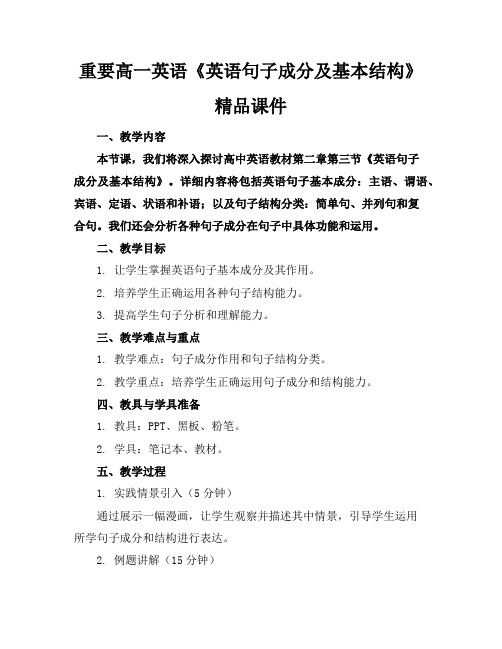
重要高一英语《英语句子成分及基本结构》精品课件一、教学内容本节课,我们将深入探讨高中英语教材第二章第三节《英语句子成分及基本结构》。
详细内容将包括英语句子基本成分:主语、谓语、宾语、定语、状语和补语;以及句子结构分类:简单句、并列句和复合句。
我们还会分析各种句子成分在句子中具体功能和运用。
二、教学目标1. 让学生掌握英语句子基本成分及其作用。
2. 培养学生正确运用各种句子结构能力。
3. 提高学生句子分析和理解能力。
三、教学难点与重点1. 教学难点:句子成分作用和句子结构分类。
2. 教学重点:培养学生正确运用句子成分和结构能力。
四、教具与学具准备1. 教具:PPT、黑板、粉笔。
2. 学具:笔记本、教材。
五、教学过程1. 实践情景引入(5分钟)通过展示一幅漫画,让学生观察并描述其中情景,引导学生运用所学句子成分和结构进行表达。
2. 例题讲解(15分钟)讲解教材中例题,分析句子成分和结构,让学生充分理解并掌握其用法。
3. 随堂练习(10分钟)设计一些有关句子成分和结构练习题,让学生当堂完成,并及时给予反馈。
4. 互动环节(10分钟)组织学生进行小组讨论,共同分析句子成分和结构在实际语境中应用。
六、板书设计1. 句子成分:主语、谓语、宾语、定语、状语、补语。
2. 句子结构:简单句、并列句、复合句。
七、作业设计1. 作业题目:It is important for us to learn English well.Tom and Jack are good friends, and they often help each other.2. 答案:(1)句子成分:主语为It,谓语为is,宾语为important,定语为for us,状语为to learn English well。
句子结构:主语+谓语+表语(形容词)结构,It作为形式主语,真正主语是to learn English well。
(2)改写后句子:Tom and Jack, being good friends, often offer each other help.八、课后反思及拓展延伸1. 反思:本节课教学效果较好,学生能基本掌握句子成分和结构知识,但在实际运用中仍需加强练习。
英语句子成分及基本结构讲义公开课获奖课件百校联赛一等奖课件

(二)句子旳详细成份
主语(subject):主语是一种句子所论述旳 主体,一般位于句首。但在there be构造、 疑问句(当主语不是疑问词时)和倒装句 中,主语位于谓语、助动词或情态动词背 面。主语可由名词、代词、数词、不定式 、动名词、名词化旳形容词和主语从句等 表达。
1 During the 1990s, American country music has become more and more popular. (名词) 2 We often speak English in class. (代词) 3 One-third of the students in this class are girls. (数词) 4 To swim in the river is a great pleasure. (不定式)
He is reading a book that he has never read.(定语从句)
状语(adverbial)
修饰动词、形容词、副词或整个句子,阐明动作或状态特征旳 句子成份,叫做状语。可由下列形式表达:
Light travels most quickly.(副词及副词性词组) He has lived in the city for ten years.(介词短语) He is proud to have passed the national college entrance examination.(不定式短语) He is in the room making a model plane.(分词短语) Wait a minute.(名词) Once you begin, you must continue.(状语从句)
2、按句子旳构造可分三种:
英语句型结构与句子成分划分复习过程
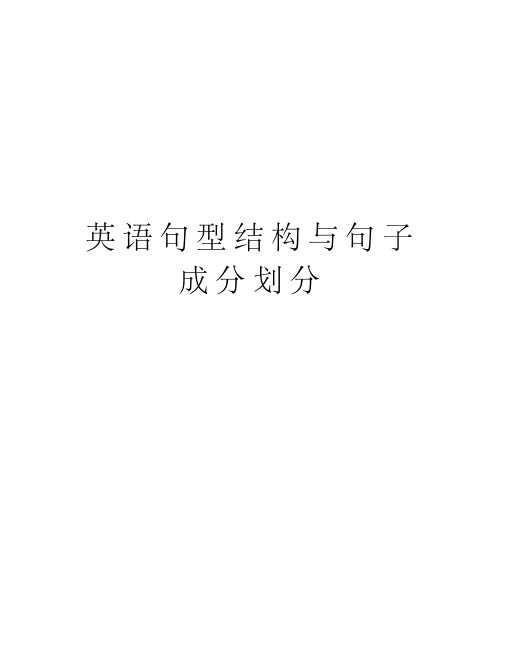
英语句型结构与句子成分划分高一英语初高中衔接练习第二讲英语句型结构与句子成分划分一、句子类型(1)、简单句:只有一个主语(或并列主语)和一个谓语动词(或并列谓语动词)构成的句子。
1) 简单句的类别1.陈述句(肯定句、否定句)2.疑问句(一般、特殊、选择、反意3.祈使句4.感叹句(How + adj. ( +S + V) ! What + n. ( +S + V) !2) 简单句的基本词序主语谓语宾语状语I bought a hat yesterday.The children ran home.The taxi driver shouted at me angrily.We ate our meal in silence.The car stopped suddenly.A young girl walked confidently on the stage.(2)、并列句:由两个或两个以上等立而又相互独立的简单句构成,两个简单句由并列连词连在一起。
其结构是:简单句+并列连词+简单句1. I help him and he helps me .2. He failed many times but he wasn’t discouraged.3. We must hurry, or we shall miss the train.4. Not only did he write to us but also he came here yesterday.or I didn’t hear well.5. Either he didn’t speak clearly(3)、复合句:简单句中的某一个成分由一个句子来充当。
1.名词性从句:主语从句、宾语从句、表语从句、同位语从句1) What he said just now is right. 2) He said that he had seen the film.3) This is why he didn’t go to school.4) The news that he has passed the exam made me happy.引导名词性从句的连词有:that, which, if, whether, who, whom, whose, when ,how, where, why, ever.2.修饰性(形容词性)从句:定语从句1) The man who is standing there is White.2) The building which was built is a school. 3) This is the place where I lived.引导定语从句的连词有:that, which, who, whom, whose, when, where, why.3. 副词性从句:状语从句(条件、时间、地点、原因、目的、结果、方式、比较、让步状语从句)引导状语从句的连词有:when, while, as, as soon as, after, since, until, till, where, if, unless, because, in order that, so…that…, though, wherever, whenever, a s …as, not so…as, than二. 句子成分划分<1>. 讨论题: 找出下列句子中相应的成分:1.Subject (主语) The sun rises in the east.2.Predicate.(谓语) We study English.3. Object(宾语) We love China.4. Predictive(表语) We are Chinese.5.Attributive/Attribute(定语) This is a difficult problem.pletement(补语) We elected him monitor.7.Adverbial(状语) He runs fast.8.Appositive(同位语) This is Miss Zou, my teacher.9.Parenthesis(插入语) To be frank, I don’t agree with you.<2> 句子成分的分类1. 主语: 主语表示句子要说明的人或事物。
- 1、下载文档前请自行甄别文档内容的完整性,平台不提供额外的编辑、内容补充、找答案等附加服务。
- 2、"仅部分预览"的文档,不可在线预览部分如存在完整性等问题,可反馈申请退款(可完整预览的文档不适用该条件!)。
- 3、如文档侵犯您的权益,请联系客服反馈,我们会尽快为您处理(人工客服工作时间:9:00-18:30)。
高一英语初高中衔接练习第二讲英语句型结构与句子成分划分一、句子类型(1)、简单句:只有一个主语(或并列主语)和一个谓语动词(或并列谓语动词)构成的句子。
1) 简单句的类别1.陈述句(肯定句、否定句)2.疑问句(一般、特殊、选择、反意3.祈使句4.感叹句(How + adj. ( +S + V) ! What + n. ( +S + V) !2) 简单句的基本词序主语谓语宾语状语I bought a hat yesterday.The children ran home.The taxi driver shouted at me angrily.We ate our meal in silence.The car stopped suddenly.A young girl walked confidently on the stage.(2)、并列句:由两个或两个以上等立而又相互独立的简单句构成,两个简单句由并列连词连在一起。
其结构是:简单句+并列连词+简单句1. I help him and he helps me .2. He failed many times but he wasn’t discouraged.3. We must hurry, or we shall miss the train.4. Not only did he write to us but also he came here yesterday.5. Either he didn’t speak clearly or I didn’t hear well.(3)、复合句:简单句中的某一个成分由一个句子来充当。
1.名词性从句:主语从句、宾语从句、表语从句、同位语从句1) What he said just now is right. 2) He said that he had seen the film.3) This is why he didn’t go to school.4) The news that he has passed the exam made me happy.引导名词性从句的连词有:that, which, if, whether, who, whom, whose, when ,how, where, why, ever.2.修饰性(形容词性)从句:定语从句1) The man who is standing there is White.2) The building which was built is a school. 3) This is the place where I lived.引导定语从句的连词有:that, which, who, whom, whose, when, where, why.3. 副词性从句:状语从句(条件、时间、地点、原因、目的、结果、方式、比较、让步状语从句)引导状语从句的连词有:when, while, as, as soon as, after, since, until, till, where, if, unless, because, in order that, so…that…, though, wherever, whenever, as …as, not so…as, than二. 句子成分划分<1>. 讨论题: 找出下列句子中相应的成分:1.Subject (主语) The sun rises in the east.2.Predicate.(谓语)We study English.3. Object(宾语)We love China.4. Predictive(表语)We are Chinese.5.Attributive/Attribute(定语)This is a difficult problem.pletement(补语) We elected him monitor.7.Adverbial(状语)He runs fast.8.Appositive(同位语)This is Miss Zou, my teacher.9.Parenthesis(插入语)To be frank, I don’t agree with yo u.<2> 句子成分的分类1. 主语: 主语表示句子要说明的人或事物。
一般由名词、代词或相当于名词的词或短语充当。
1)The students study hard.2)He usually goes to school at 7:30.3)One and one make two.4)To tell a lie is wrong.5)Learning a foreign language takes a long time.6)Who taught you English last year?2. 谓语:说明主语的动作或状态。
谓语和主语在“人称”和“数”两方面必须一致(1) 由动词的各种时态语态表示。
1) He goes to school every day. 2) They are swimming.3) She caught up with the others very quickly.4) This kind of machine is made in China.(2) 由“情态动词+动词原形”表示。
We must work hard at English.The recorder can be repaired in two days.(3) 由“连系动词+表语”表示。
My father is a doctor.He feels better today.3. 表语: 表语和连系动词一起构成谓语,表示主语的性质、特征、身份等。
一般由名词、形容词或相当于名词、形容词的词或短语充当。
1) Her uncle is a teacher. 2) He became angry.3) The weather is getting warmer and warmer.4. 宾语: 动作的承受者1) The child needs help. 2) They all helped us. 3) I hope to see you again.4) Tom likes swimming 5) He gave me a map of the world. 6) I’ll lend it to you tomorrow.7) My mother bought a skirt for me.有些及物动词需要两个宾语,一个指物,一个指人。
指物的叫直接宾语,指人的叫间接宾语。
间接宾语一般放在直接宾语之前,但为了强调间接宾语,可把间接宾语放在直接宾语之后,这时要在间接宾语前加介词to或for.5.宾语补足语有些动词除需要一个宾语外,还得有一个宾语补足语,句子意义才能完整。
宾语和宾语补足语一起构成复合宾语。
宾语和宾语补足语在逻辑上有主谓关系,这是宾语和宾语补足语的主要依据。
1) We found the story quite interesting. 2) We asked him to help us.3) I saw a child playing on the grass.6. 定语: 定语修饰名词或代词。
1) Our classroom is clean and bright. 2) The book here is very interesting.3) The man in a brown jacket is my father.4) This is the house where I lived three years ago.5) The students’ reading-room is on the second floor.英语中放在被修饰词(中心词)前面的成为前置定语放在被修饰词后面的称为后置定语。
一般来说,当定语修饰some, any, every, no等所构成的复合不定代词时,定语需后置。
1) I have something important to tell you.2) There is nothing wrong with the sentence.7.状语修饰动词、形容词或副词,也可以修饰整个句子。
状语说明地点、时间、目的、结果、条件、让步、方式、程度等。
如果状语和地点状语同时出现,一般是时间状语放在最后,地点状语放在时间状语之前。
He was born in shanghai in 1970.The meeting is to be held in Room 401 tomorrow evening.8. 同位语This is Mr.Zhou, our teacher.9.插入语To be honest, I don’t agree with you.三. 五种简单句的结构1.主语+连系动词+表语连系动词的类别:(1) be(2) 感官动词:look, seem, appear, smell, taste, sound, feel(3) 表持续的动词:remain, keep , stay, continue(4) 表变化的动词:get, become, turn, grow ,练习1: 翻译下列句子:1) 这座花园香气怡人。
2) 丝绸摸起来又软又滑。
2.主语+不及物动词(常+状语)Tom died.练习2: 翻译下列句子:3) 水开了.4) 我们努力学习。
5) 火车就要开了。
6) 旗帜在风中飘动。
3.主语+及物动词+宾语We study English.4.主语+及物动词+间宾+直宾练习3: 翻译下列句子:7) 我给他一些钱.8) 他为我买了一本书.▲一些间接宾语可改成由to引起的短语,表示动作向谁。
▲一些间接宾语可改成由for引起的短语,表示动作为谁5.主语+及物动词+宾语+宾补练习3: 翻译下列句子:9) 我们认为这工作容易。
10) 我们选他当班长。
练习4: 翻译下列句子:11) 那消息使我很高兴。
12) 他听见有人在开门。
13) 那故事使我们笑了起来。
▲There be 结构There is a computer on the desk.练习5: 翻译下列句子:14) 课室里有很多桌子。
15) 树下有一个漂亮的女孩。
练习6: 划分下列斜体字部分的句子成分:1.The price is going down a bit in the car market abroad.2.The young should respect the old.3. Laying eggs is ant queen’s full-time job.4. She was the first to win the Nobel Prize twice.5.He returned a white-haired, wise old man.6.To swim across the Channel is a wonderful experience.7. There remains much to talk about.8. How long did the Civil war last?9. The dying is taken good care of in his hospital.10.There is no need to have further discussion about it.11. All has changed since the rules were made.12. It doesn’t matter whether it rains or not.13. It sounds like a train that is going under the house.14. The man was found dead the next day.15. What people need most now is the sense of safety?16. On the top of the hall flies a red flag.五种简单句的结构1) .The garden smells pleasant.2) .Silk feels soft and smooth. 3) The water boiled. 4) We study hard. 5) The train is starting. 6) The flag is flowing in the wind. 7) I gave him some money. (I gave some money to him) 8) He bought me some books. ( He bought some books for me) 9) I think the job easy.10) We elected him monitor. 11) The news made me happy. 12) I heard somebody knocking at the door. 13) The story made us laugh. 14) There were many desks in the classroom. 15) There is a pretty girl under the tree.练习6: 划分下列斜体字部分的句子成分:1.The price is going down a bit in the car market abroad.谓定adv.2. The young should respect the old.主adj.谓vt.3. Laying eggs is ant queen’s full-time job.主Ger 表n.4. She was the first to win the Nobel Prize twice.表num5. He returned a white-haired, wise old man.谓vi. 定par-/adj.6. To swim across the Channel is a wonderful experience.主Inf7. There remains much to talk about.主pron.定Inf8. How long did the Civil war last?状adv. 谓vi.9. The dying is taken good care of in his hospital.主adj. 状prep.10. There is no need to have further discussion about it.定Inf11. All has changed since the rules were made.主pron. 状从12. It doesn’t matter whether it rains or not.谓vi主从13. It sounds like a train that is going under the house.表prep.定从14. The man was found dead the next day.谓vi 补adj.15. What people need most now is the sense of safety?主从表n.16. On the top of the hall flies a red flag.状prep. 主n.。
